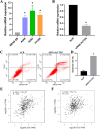Identifies KCTD5 as a novel cancer biomarker associated with programmed cell death and chemotherapy drug sensitivity
- PMID: 37149576
- PMCID: PMC10163697
- DOI: 10.1186/s12885-023-10895-2
Identifies KCTD5 as a novel cancer biomarker associated with programmed cell death and chemotherapy drug sensitivity
Abstract
Background: More and more studies have demonstrated that potassium channel tetramerization domain-containing 5 (KCTD5) plays an important role in the development of cancer, but there is a lack of comprehensive research on the biological function of this protein in pan-cancer. This study systematically analyzed the expression landscape of KCTD5 in terms of its correlations with tumor prognosis, the immune microenvironment, programmed cell death, and drug sensitivity.
Methods: We investigated a number of databases, including TCGA, GEPIA2, HPA, TISIDB, PrognoScan, GSCA, CellMiner, and TIMER2.0. The study evaluated the expression of KCTD5 in human tumors, as well as its prognostic value and its association with genomic alterations, the immune microenvironment, tumor-associated fibroblasts, functional enrichment analysis, and anticancer drug sensitivity. Real-time quantitative PCR and flow cytometry analysis were performed to determine the biological functions of KCTD5 in lung adenocarcinoma cells.
Results: The results indicated that KCTD5 is highly expressed in most cancers and that its expression is significantly correlated with tumor prognosis. Moreover, KCTD5 expression was related to the immune microenvironment, infiltration by cancer-associated fibroblasts, and the expression of immune-related genes. Functional enrichment analysis revealed that KCTD5 is associated with apoptosis, necroptosis, and other types of programmed cell death. In vitro experiments showed that knockdown of KCTD5 promoted apoptosis of A549 cells. Correlation analysis confirmed that KCTD5 was positively correlated with the expression of the anti-apoptotic genes Bcl-xL and Mcl-1. Additionally, KCTD5 was significantly associated with sensitivity to multiple antitumor drugs.
Conclusion: Our results suggest that KCTD5 is a potential molecular biomarker that can be used to predict patient prognosis, immunoreactions and drug sensitivity in pan-cancer. KCTD5 plays an important role in regulating programmed cell death, especially apoptosis.
Keywords: Cell apoptosis; Drug sensitivity; KCTD5; Pan-cancer; Prognosis; Tumor microenvironment.
© 2023. The Author(s).
Conflict of interest statement
There are no conflicts of interest.
Figures










References
MeSH terms
Substances
Grants and funding
LinkOut - more resources
Full Text Sources
Medical
Research Materials

